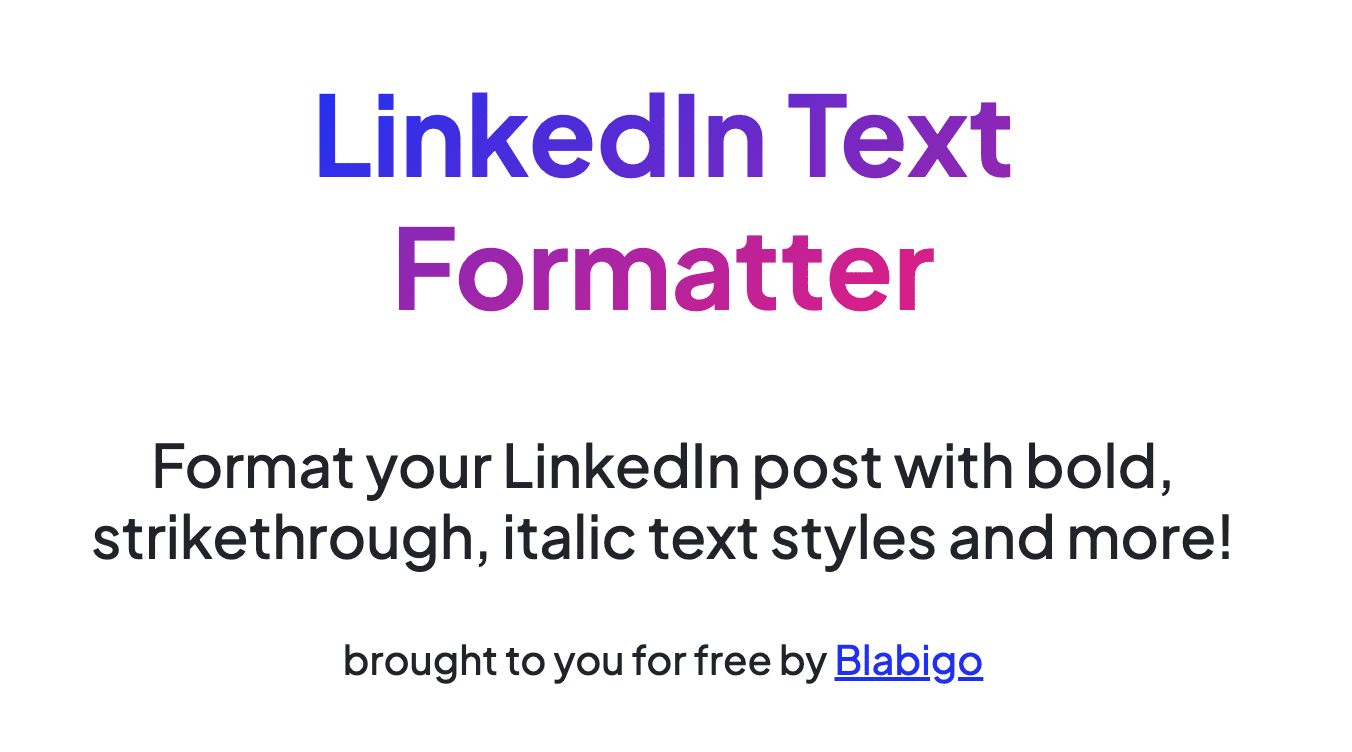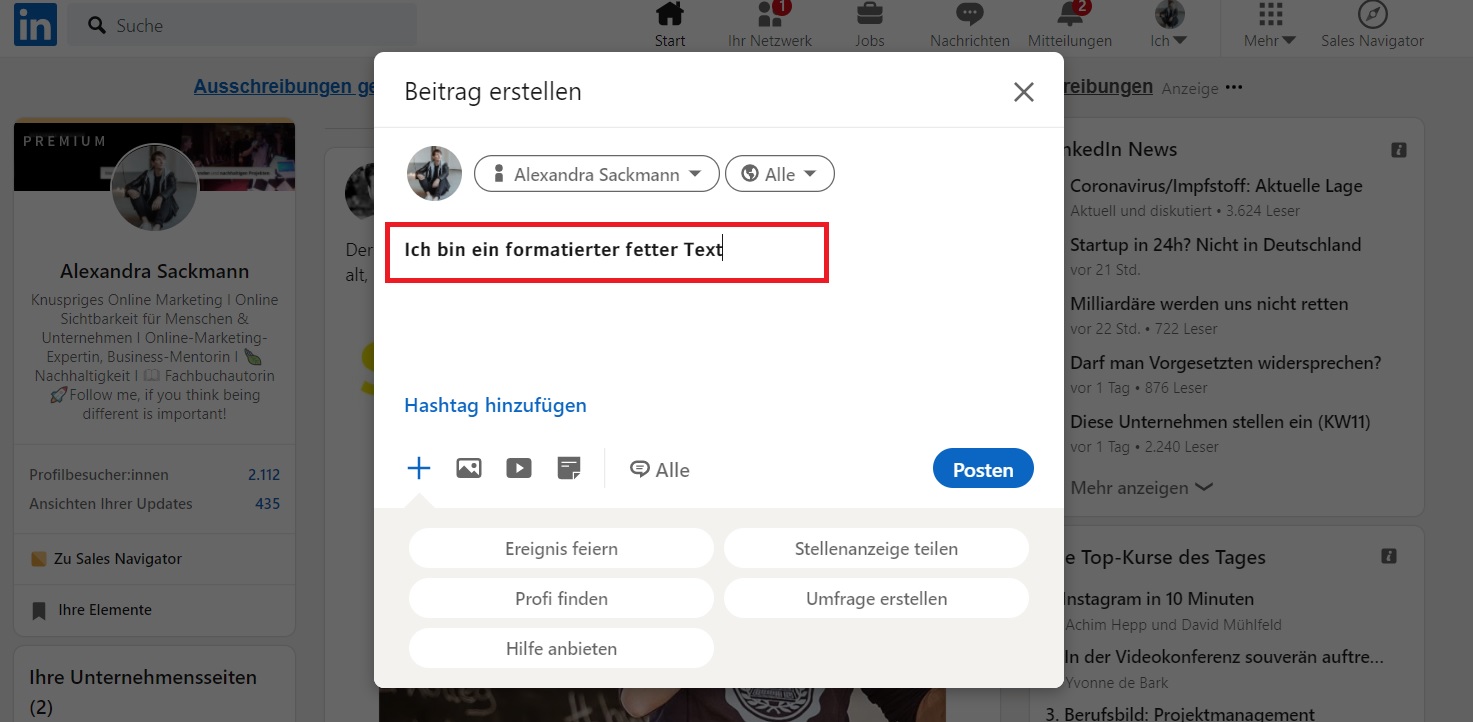When it comes to crafting posts on LinkedIn, the way you format your text can make a world of difference. A well-structured post grabs attention, conveys your message clearly, and encourages interaction. With the right formatting techniques, you can elevate your content, making it not just informative but also visually appealing. Whether you’re sharing industry insights, personal stories, or professional achievements, knowing how to format your text effectively can enhance your visibility and engagement on this professional networking platform.
Why Formatting is Important for Engagement

Formatting your LinkedIn posts isn’t just about aesthetics; it plays a crucial role in engagement and readability. Here’s why it matters:
- Grabs Attention: In a sea of content, a visually appealing post stands out. Using bullet points, bold text, and line breaks can draw the reader's eye to key points.
- Enhances Readability: Large blocks of text can be overwhelming. By breaking your content into digestible sections, you help readers absorb the information more easily.
- Encourages Interaction: Posts that are easy to read and well-structured often receive more likes, comments, and shares. This interaction can lead to more visibility in your network.
- Establishes Professionalism: A neatly formatted post reflects professionalism. It indicates that you value your audience’s time and are serious about the content you share.
In essence, effective text formatting on LinkedIn can significantly enhance your message's reach and impact, making it easier for your audience to engage with your content. When you take the time to format your posts thoughtfully, you're not just sharing information; you’re inviting conversation and community.
Also Read This: How to Add Your CompTIA Certification to LinkedIn for Maximum Visibility
3. Basic Text Formatting Options

When crafting a post on LinkedIn, you might want to emphasize certain points or make your content more engaging. Fortunately, LinkedIn offers a few basic text formatting options that can help you achieve this.
Firstly, let’s talk about bold text. While LinkedIn doesn’t have a built-in option for bolding text, you can use external tools to generate bold characters. Websites like LingoJam's Bold Text Generator allow you to type your content, generate it in bold, and then copy it over to LinkedIn. Just remember, overusing bold can diminish its impact.
Next is italic text. Similar to bold, you can also create italicized text using third-party tools. Italics can be effective for emphasizing quotes or certain phrases. It adds a nice touch of variety to your text!
Lastly, don’t forget about line breaks. They’re essential for improving the readability of your post. A well-structured post with appropriate spacing makes it easier for your audience to digest information. Aim for short paragraphs, and consider separating different ideas with line breaks.
In summary, while LinkedIn provides limited formatting options, using bold or italic text and strategic line breaks can significantly enhance your posts.
Also Read This: Understanding the Check Mark Symbol in LinkedIn Messages
4. Using Bullet Points and Numbered Lists
Lists are a fantastic way to present information clearly on LinkedIn. They help break down complex ideas into bite-sized, digestible pieces. Plus, they make your posts visually appealing!
When using bullet points, consider them for items that don't follow a specific order, like tips or features. For example:
- Engage with your audience regularly
- Share industry insights
- Post multimedia content for variety
On the other hand, numbered lists are perfect when you want to present a sequence or hierarchy. For instance, if you're outlining steps to improve your LinkedIn profile, you might say:
- Choose a professional profile picture.
- Craft a compelling headline.
- Highlight your skills and endorsements.
Using these formatting techniques not only enhances clarity but also encourages engagement. Readers are more likely to interact with a post that’s easy to skim through. So, next time you’re posting on LinkedIn, consider using bullet points or numbered lists to make your content stand out!
Curl error: OpenSSL SSL_connect: SSL_ERROR_SYSCALL in connection to chatgpt4online.org:443
Also Read This: Can Changing Your Name on LinkedIn Cause You to Lose Followers?
Incorporating Emojis and Symbols
Emojis and symbols can add a splash of personality and engagement to your LinkedIn posts. They help to break up text and draw attention to key points. But how do you use them effectively?
First, consider your audience. LinkedIn is a professional platform, so opt for emojis that reflect your industry or the tone of your message. For example, if you're posting about a tech innovation, a light bulb 💡 might be appropriate. On the other hand, if you're sharing a personal success story, a trophy 🏆 can convey achievement.
Here are a few tips for incorporating emojis and symbols:
- Use Sparingly: Don’t overdo it. A sprinkle of emojis can enhance your post, but too many can make it seem unprofessional.
- Pair with Text: Use emojis to complement your words. For instance, “Excited to announce our new product 🚀” gives a visual cue that matches your enthusiasm.
- Bullet Points and Lists: Emojis can be used as bullet points to make lists more engaging. For example:
| Tips for Effective Posts | Emoji |
|---|---|
| Be Authentic | ✨ |
| Stay Professional | 💼 |
| Encourage Engagement | 💬 |
In summary, when used thoughtfully, emojis and symbols can make your LinkedIn posts stand out and resonate more with your audience.
Also Read This: How to Avoid Extra Spaces When Copying from LinkedIn to Your Clipboard
Crafting Attention-Grabbing Headlines
Your headline is the first impression your LinkedIn post makes, so it’s crucial to make it count! A compelling headline not only grabs attention but also encourages readers to engage further with your content.
To craft a captivating headline, consider these strategies:
- Use Numbers: Headlines with numbers tend to perform well. For example, “5 Key Strategies for Effective Networking” promises specific takeaways.
- Ask Questions: Engage your audience by posing a question. Something like “Are You Making These Common LinkedIn Mistakes?” sparks curiosity and invites discussion.
- Be Clear and Concise: Avoid vague terms; make sure your headline conveys the essence of your post. For instance, “How to Optimize Your LinkedIn Profile” is straightforward and informative.
- Incorporate Keywords: Think about what your audience is searching for. Using relevant keywords improves visibility and connects with readers’ interests.
Here’s a quick format you might follow:
- Attention Grabber: A surprising statistic or bold statement.
- Benefit or Promise: What will readers gain by reading your post?
For example, “Unlock the Secrets of LinkedIn: 7 Tips to Boost Your Professional Presence” is catchy and promises value.
In essence, a well-crafted headline not only enhances your post’s visibility but also entices readers to dive into your content!
Also Read This: How to Add an Experience Section to Your LinkedIn Profile
7. Best Practices for Formatting Your Post
When it comes to creating engaging LinkedIn posts, how you format your text can make all the difference. Here are some best practices to consider:
- Use Short Sentences: Keep your sentences concise. This makes your post easier to read and digest. Aim for an average of 10-15 words per sentence.
- Break Up Text with Paragraphs: Large chunks of text can overwhelm readers. Use paragraphs to break your content into manageable sections.
- Utilize Bullet Points: When listing key points or steps, bullet points can help highlight them. For example:
- Start with a hook to grab attention.
- Include relevant hashtags.
- End with a call to action.
- Incorporate Emojis: Emojis can add a visual element to your post, making it more engaging. Just use them sparingly to maintain professionalism.
- Use Headings and Subheadings: If your post is longer, consider using headings to guide readers through your content. This helps in scanning through information quickly.
- Highlight Key Terms: Bold important words or phrases to draw attention. This aids in emphasizing your main points.
By following these best practices, you’ll create posts that not only look good but also communicate your message effectively.
8. Conclusion and Final Thoughts
Formatting your LinkedIn posts effectively is crucial for engagement and readability. With the tips outlined above, you can elevate your posts from mundane to captivating.
Remember, the goal is to convey your message clearly and attractively. Here's a quick recap of what we’ve covered:
- Use short sentences and paragraphs to improve clarity.
- Incorporate bullet points for easy reading.
- Add emojis and bold text to enhance visual appeal.
- Consider headings for longer posts to aid navigation.
In conclusion, don't underestimate the power of good formatting! It can significantly enhance your visibility and engagement on LinkedIn. So, the next time you sit down to craft a post, keep these formatting tips in mind. Happy posting!
 admin
admin








